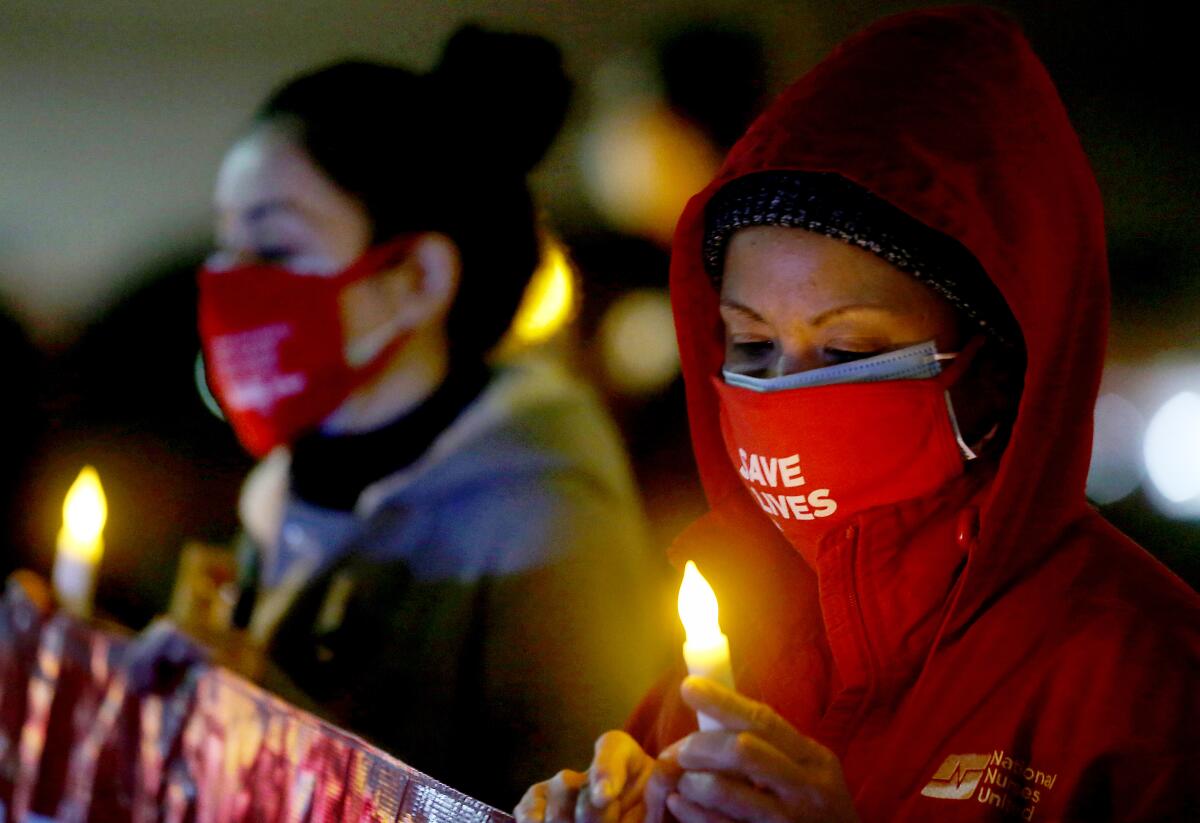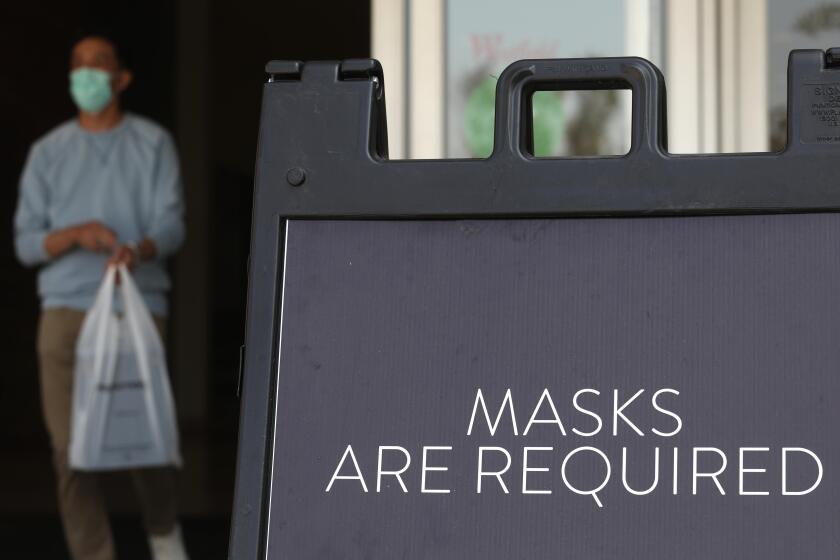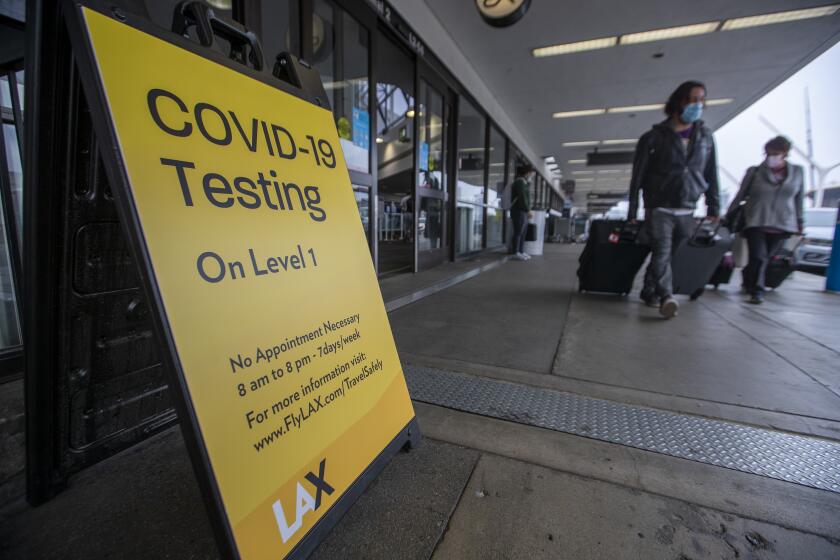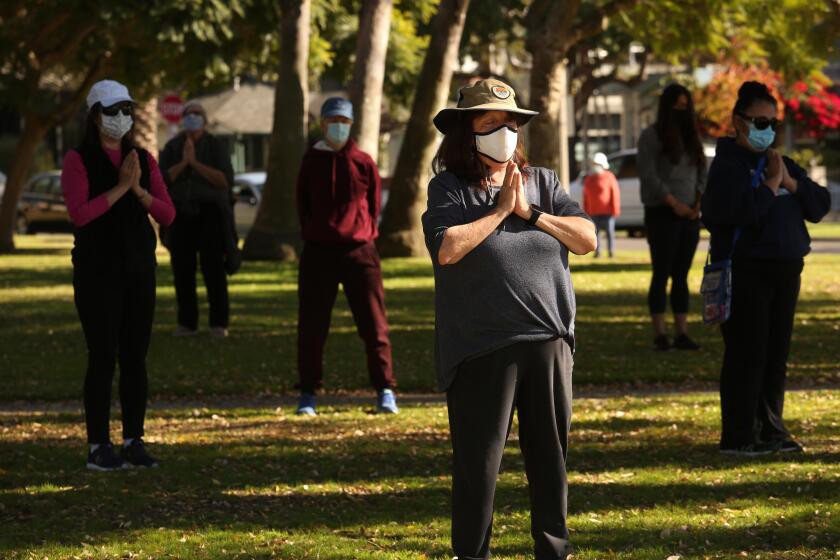Newsom warns of regional stay-at-home order as COVID-19 hospitalizations hit record

Gov. Gavin Newsom on Monday warned that California is again on the brink of a wider coronavirus stay-at-home order as public health officials work desperately to shore up a state hospital system that’s contending with record numbers of COVID-19 patients.
Should recent trends continue, officials warn, there’s a chance that the viciously resurgent pandemic could overwhelm aspects of the state healthcare system.
Of particular concern is California’s intensive care unit capacity. Currently, about 75% of the state’s 7,733 ICU beds are occupied — with 1,812 of them filled by coronavirus patients.
Unless things change, the state could exhaust its existing ICU capacity by mid-December, according to projections Newsom presented.
The rural counties of Northern California could exceed ICU capacity by early December; Southern California and the San Joaquin Valley by mid-December, the Sacramento area by late December and the Bay Area by early January.
“If these trends continue, we’re going to have to take much more dramatic — arguably drastic — actions,” Newsom said during a briefing.
‘Potential for a stay-at-home order’
Those include “the potential for a stay-at-home order” for areas in the strictest purple tier of California’s coronavirus reopening road map, he said. It’s possible such a stay-at-home order would be imposed only on counties in the worst shape among those in the purple tier. “We will be coming out with some additional information, some additional recommendations in the very, very near future,” Newsom said.
Of the state’s 58 counties, 51 are in the purple tier — comprising 99% of California’s population. The only ones that aren’t are Sierra, Marin, Amador, Alpine, Mono, Mariposa and Inyo.
There are more COVID patients in California hospitals than ever before, sparking a race to tamp down the increase before the healthcare system is overwhelmed.
Officials have watched with growing alarm as a recent record-setting flood of new coronavirus cases has started to wash over the state’s hospital system.
There were 7,787 coronavirus patients hospitalized statewide as of Sunday, according to the latest available data. That’s the highest number recorded during the pandemic — the second consecutive day the record for COVID-19 hospitalizations has been broken. That’s a tripling of hospitalizations since Nov. 2, when 2,602 people were in the hospital with coronavirus infections.
COVID-19 cases requiring intensive care have tripled since Oct. 14, when 600 people were in ICU beds, to 1,812 reported on Sunday.
‘Seriously bad numbers’
“It’s brutal. It’s astoundingly bad. ... They’re seriously, seriously bad numbers,” said Dr. George Rutherford, epidemiologist and infectious-diseases control expert at UC San Francisco. “We don’t have any place to decompress patients, because stuff that’s just as bad is going on in Oregon and Nevada and Arizona.
“We are here on our own, and this is a natural disaster. And we need to be able to avoid the worst parts of this as much as possible. And if there were ever a time for prevention and heeding advice, this is it,” Rutherford said.
So far, the stricter approach California has taken — to err on the side of saving lives — has kept the death toll from exploding as much as it has in other states on a per capita basis.
But the current figures largely don’t include the recent deluge of infections — as COVID-19 hospitalizations reflect cases that were identified two to three weeks earlier, according to Dr. Mark Ghaly, California’s health and human services secretary.
Record high coronavirus cases
On Monday, California broke the single-day record for coronavirus cases: 21,848, surpassing a high set the previous Monday, when 20,654 cases were recorded. By Monday night, California was averaging about 14,000 coronavirus cases a day over a seven-day period, a record, and about 63 deaths a day.
“This is exactly the trendline we most feared, and one we most fear going forward,” Newsom said. “The red flags are flying in terms of the trajectory and our projections of growth.”
That trajectory is a tripling of daily coronavirus cases since Halloween and more than a 50% increase in daily deaths since election day.
Given the severity of the surge, Ghaly said Monday, everything “is on the table in terms of considering how we effectively guide the state through this,” though he said California is “working with our local partners to make sure what we do is both impactful and as time-limited as possible.”
A projection cited by Los Angeles Mayor Eric Garcetti has 4,000 more L.A. County residents dying of COVID-19 by the year’s end. But experts say that dire outcome is avoidable.
The stakes for hospitals are high.
Possible crisis by Christmas Eve
Newsom said about 59% of California’s hospital beds are currently occupied by patients needing care for all sorts of reasons — but that could rise to 78% by Christmas Eve.
He emphasized that the alarming numbers would come to pass if “we just sit back and we are bystanders at this moment and we don’t subsequently improve upon our existing efforts.”
“We intend to bend this proverbial curve and impact these statistics favorably,” he said.
Still, it will be a few weeks before the full impact of the current surge is realized.
State health officials have estimated that roughly 12% of those who have tested positive for the coronavirus have been hospitalized two to three weeks later.
Daily death toll could rise into 2021
A surge in transmission over the Thanksgiving weekend, for example, would only be reflected in a jump in positive cases by mid-December, and then a surge in hospitalizations around Christmas and New Year’s Day, followed by a rise in daily deaths in early to mid-January.
The specter of additional state-level restrictions comes as some counties are already taking additional steps aimed at tamping down transmission of the coronavirus.
Los Angeles County’s strictest rules in months went into effect Monday, while Santa Clara County has ordered a mandatory 14-day quarantine for virtually anyone coming into the county from more than 150 miles away — with some exceptions, such as for people traveling for medical treatment.
The new rules, affecting stores, playgrounds and gatherings, are less severe than the stay-at-home order initiated in the spring.
Officials in both counties have warned that unless they can halt the coronavirus surge, hospitals could run out of beds in weeks.
The L.A. County director of public health, Barbara Ferrer, put it bluntly: “We are at the most difficult moment in the pandemic.” On Monday, L.A. County surpassed another milestone of tallying more than 400,000 cumulative coronavirus cases, and more than 7,650 deaths.
Daily deaths have tripled in L.A. County
The county is now averaging more than 4,000 new coronavirus cases a day on a weekly basis, quadruple the number from mid-October, and averaging about 30 deaths a day, triple the rate from the beginning of November.
According to state data released Monday, L.A. County broke a new record for COVID-19 hospitalizations — surpassing its previous all-time high of 2,232 set on July 18, and on Sunday, posted a total of 2,316 people in its hospitals with confirmed coronavirus infections.
The rate of increasing hospitalizations in L.A. County has been breathtaking: tripling from a total of 777 recorded on Halloween.
“The increases we’re seeing now are not sustainable. They’re not sustainable because they’re gonna overwhelm not just our healthcare system, but the entire state’s healthcare system,” Ferrer said. “We are very worried. And I easily anticipate seeing even higher numbers out before this week is over.”
Officials in L.A. County rolled out a “targeted safer-at-home order” that is in effect through Dec. 20. It closes public playgrounds; places new capacity limits on retail stores, outdoor museums, galleries, zoos and aquariums; and prohibits all gatherings among people from different households, except for outdoor religious services and political demonstrations.
Those limitations are on top of other restrictions that went into effect last week, including a controversial renewed ban on outdoor dining.
Many people aren’t wearing masks at gatherings
Though she acknowledged the disruption and pain that come with new restrictions, Ferrer said health officials have tried to be more targeted in their efforts to slow the spread of the disease.
But, she said, the county can’t sit idly by as conditions worsen — particularly in terms of the healthcare system. Ferrer said the county and the state Department of Public Health are working to map out a strategy to get the pandemic back under control, although she holds out hope that the strategy can be done without needing to have people completely stay home.
“We’re going to have to do everything we can, and hopefully everyone gets on board with this. It’s three weeks. We’ve done this for much longer in the past and with many more restrictions,” Ferrer said of the existing health order.
Ferrer disagreed with criticism that L.A. County’s approach hasn’t worked. “If we hadn’t done anything, we’d be in much worse shape,” Ferrer said, pointing out to other areas around the country whose hospital systems are already overwhelmed.
Ferrer said one reason why L.A. County decided to ban outdoor gatherings in a new health order that went into effect Monday was because many people weren’t actually following state requirements to wear masks and keep six feet away from each other. “In fact, they were in places where people were often eating and drinking, without their masks on,” Ferrer said.
Ferrer said she understands that the three-week closure of playgrounds creates hardship for families. But she said her agency has heard of issues from parks officials that playgrounds have been extraordinarily crowded; it’s hard to do significant infection control; and many children are often seen at the playgrounds without wearing a face covering and interacting with people who aren’t in their households.
Travel quarantine in effect in Santa Clara County
In Santa Clara County, hotel use has been restricted to essential travel only or to people needing medical isolation or quarantine. Capacity at retail establishments was also further capped.
“We have come to a place where our cases and our hospitalizations are so high that we must do something to settle things down,” Dr. Sara Cody, the health officer for Santa Clara County, said Saturday. “We are now at a critical inflection point.”
Authorities also suspended contact sports for professional teams, forcing the San Francisco 49ers to look elsewhere to play their home games scheduled for December.
“This pandemic is like a high-speed train, and our projections tell us that we are on target to derail by around the third week of December if we don’t apply brakes, right now, with all our collective might,” Cody said. “We urge everyone to stay home to the greatest extent that you can. Please stay home. Do not go out unless it is for essential reasons or essential purposes.”
While acknowledging that the rules present further challenges to businesses already reeling from months of coronavirus-related limitations, officials have said the restrictions, combined with residents’ adherence to the practices that can help keep them and their loved ones safe, will help turn back the tide of new infections.
However, given the lagging nature of the virus, it will take weeks before the numbers reflect either the benefits of increased public vigilance and health interventions or the ramifications of a potentially significant source of new infections — such as gatherings for the recent Thanksgiving holiday.
“Yes, we’re asking a lot. Yes, people are going to need to make more sacrifices,” Ferrer said. “But if we don’t get this virus under control, it will cost all of us dearly.”
Times staff writers Alex Wigglesworth and Ryan Menezes contributed to this report.
More to Read
Sign up for Essential California
The most important California stories and recommendations in your inbox every morning.
You may occasionally receive promotional content from the Los Angeles Times.















